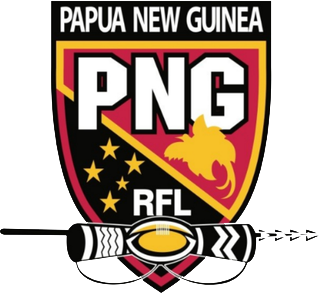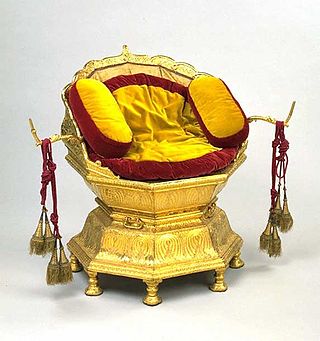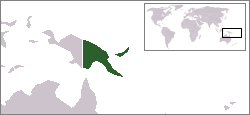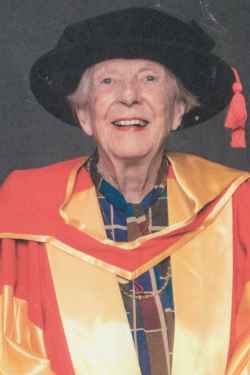
Papua New Guinea, officially the Independent State of Papua New Guinea, is a country in Oceania that comprises the eastern half of the island of New Guinea and its offshore islands in Melanesia. It shares its only land border with Indonesia to the west and it is directly adjacent to Australia to the south and the Solomon Islands to the east. Its capital, located along its southeastern coast, is Port Moresby. The country is the world's third largest island country, with an area of 462,840 km2 (178,700 sq mi).

The Papua New Guinea national rugby league team represents Papua New Guinea in the sport of rugby league football.

Western Highlands is a province of Papua New Guinea. The provincial capital is Mount Hagen. The province covers an area of 4,299 km2, and there are 362,850 inhabitants, making the Western Highlands the most densely populated province. Tea and coffee are grown in the Western Highlands.

Southern Highlands is a province in Papua New Guinea. Its provincial capital is the town of Mendi. According to Papua New Guinea's national 2011 census, the total population of Southern Highlands is 515,511 spread across 15,089 square kilometers (5,826 sq mi).

The culture of Papua New Guinea is many-sided and complex. It is estimated that more than 7000 different cultural groups exist in Papua New Guinea, and most groups have their own language. Because of this diversity, in which they take pride, many different styles of cultural expression have emerged; each group has created its own expressive forms in art, dance, weaponry, costumes, singing, music, architecture and much more. To unify the nation, the language Tok Pisin, once called Neo-Melanesian has evolved as the lingua franca — the medium through which diverse language groups are able to communicate with one another in Parliament, in the news media, and elsewhere. People typically live in villages or dispersed hamlets which rely on the subsistence farming of yams and taro. The principal livestock in traditional Papua New Guinea is the oceanic pig.
Rugby league is a popular team sport in Papua New Guinea, and is the national sport. Papua New Guinea has a reputation for being the most passionate supporter of the game in the world.

The Papua New Guinea men's national cricket team, nicknamed the Barramundis, is the team that represents the country of Papua New Guinea in international cricket. The team is organised by Cricket PNG, which has been an Associate Member of the International Cricket Council (ICC) since 1973. Papua New Guinea previously had One-Day International (ODI) status, which it gained by finishing fourth in 2014 World Cup Qualifier. Papua New Guinea lost both their ODI and T20I status in March 2018 after losing a playoff match against Nepal during the 2018 Cricket World Cup Qualifier, a result that earned ODI and T20I status for their opponents. On 26 April 2019, PNG defeated Oman to secure a top-four finish in the 2019 ICC World Cricket League Division Two and reclaim their ODI status.

The Papua New Guinea national Australian rules football team represents Papua New Guinea in the team sport of Australian rules football. It is one of the nation's most successful sporting teams, currently ranked 2nd in the world behind Australia.

Australian rules football in Papua New Guinea (PNG) is a developing team sport which was initially introduced by Australian servicemen during World War II. The governing body for the sport is the PNG Rules Football Council, with the development body being AFL PNG. The junior development version is known locally as Niukick. Regionally, AFL PNG is affiliated with AFL Oceania.

Papua New Guinean art has a long rich diverse tradition. In particular, it is world-famous for carved wooden sculpture: masks, canoes and story-boards. Papua New Guinea also has a wide variety of clay, stone, bone, animal and natural die art. Many of the best collections of these are held in overseas museums.

Islam in Papua New Guinea is a minority religion in the predominantly Christian country, with around 10,000 followers as of 2021. Papuan Muslims are largely concentrated Port Moresby and villages situated in the Highlands. Due to secular nature of the country's constitution, Muslims are free to proselytize and build places of worship in the country.
Timothy Akis, born around 1944 in Tsembaga village, Simbai Valley, Madang Province, Papua New Guinea, died in 1984, was a Papua New Guinean artist. His art consisted primarily in imaginative pen and ink drawings and batiks inspired by his country's wildlife.

Maharaja Ranjit Singh's throne was made by the goldsmith Hafez Muhammad Multani about 1820 to 1830, for the eponymous ruler of the Sikh empire. It is made of a wood and resin core, covered with sheets of repoussé, chased and engraved gold.

The Royal Papua New Guinea Constabulary (RPNGC) is a national police force with jurisdiction throughout all of Papua New Guinea.

The American Museum of Asmat Art is a gallery exhibiting the art and culture of the Asmat people of southwestern Papua, Indonesia, housed at the University of St. Thomas in St. Paul, Minnesota. Featuring more than 2,200 objects, it is one of the largest of its kind in the United States. Asmat art is widely collected in major Western museums despite the difficulty in visiting the remote region to collect work; the "exceptionally expressive" art "caused a sensation in art-collecting circles" which led to large-scale collecting expeditions in the post-WWII era, according to art scholar and ethnology Dirk A.M. Smidt. The gallery includes a permanent display of Asmat works such as ancestor poles (bis) and canoes, and a rotating exhibition highlighting aspects of Asmat art and culture. Much of the collection is accessible through the museum's online database.
Onga/Waffa Rural LLG is a local-level government (LLG) of Morobe Province, Papua New Guinea.

Papua New Guinea (PNG) is officially known as the Independent State of Papua New Guinea after gaining absolute independence from Australia on September 16, 1975. PNG is the largest country in the South Pacific region and comprises the eastern side of New Guinea including its islands. Crime in Papua New Guinea, both violent and non-violent, have contributed to the developing country's crime rate being one of the highest in the world.

The COVID-19 pandemic in Papua New Guinea is part of the worldwide pandemic of coronavirus disease 2019 caused by severe acute respiratory syndrome coronavirus 2. The virus was confirmed to have reached Papua New Guinea on 20 March 2020. On 4 May 2020, Papua New Guinea was declared COVID-19 free. However, on 20 June, the government confirmed another case of COVID-19, meaning that the disease was present again within the country.

Anima Mundi is a museum of ethnological art and artefacts in the Vatican City. It is part of the Vatican Museums.

Ellen Maev O'Collins, MBE was an Australian social worker by training, who became Emeritus Professor in the Department of Anthropology and Sociology at the University of Papua New Guinea.


















